301 Physical Standards
1.0 Physical Standards for Flats
1.1 General Definition of Flat Size Mail
[7-15-07] Flat-size mail other than that in 3.0, Physical Standards for Automation Flats, is:
a. More than 11-1/2 inches long, or more than 6-1/8 inches high, or more than 1/4 inch thick.
b. Not more than 15 inches long, or more than 12 inches high, or more than 3/4 inch thick, except for Periodicals mail under 707.26.0.
c. Rectangular with four square corners or with finished corners that do not exceed a radius of 0.125 inch (1/8 inch). See Exhibit 1.1c.
Exhibit 1.1c Maximum Corner Radius for Flat-Size Mailpieces
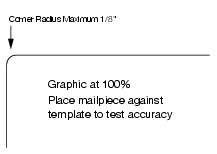
d. Other size or weight standards may apply to mail claimed at certain prices, mail addressed to certain APOs and FPOs, and mail sent by the Department of State to U.S. government personnel abroad.
1.2 Length and Height of Flats
The length of a flat-size mailpiece is the longest dimension. The height is the dimension perpendicular to the length.
1.3 Minimum Flexibility for Flat-Size Pieces
[8-16-07] Flat-size pieces must be flexible. Boxes—with or without hinges, gaps, or breaks that allow the piece to bend—are not flats. Tight envelopes or wrappers that are filled with one or more boxes are not flats. At the customer's option, a customer may perform the following test on their own mailpieces. When a postal employee observes a customer demonstrating that a flat-size piece is flexible according to these standards, the employee does not need to perform the test. Test flats as follows:
a. All flats (see Exhibit 1.3a):
1. Place the piece with the length parallel to the edge of a flat surface and extend the piece halfway off the surface.
2. Press down on the piece at a point 1 inch from the outer edge, in the center of the piece's length, exerting steady pressure.
3. The piece is not flexible if it cannot bend at least 1 inch vertically without being damaged.
4. The piece is flexible if it can bend at least 1 inch vertically without being damaged and it does not contain a rigid insert. No further testing is necessary.
5. Test the piece according to 1.3b. or 1.3c. below if it can bend at least 1 inch vertically without being damaged and it contains a rigid insert.
Exhibit 1.3a Flexibility Test—All Flats
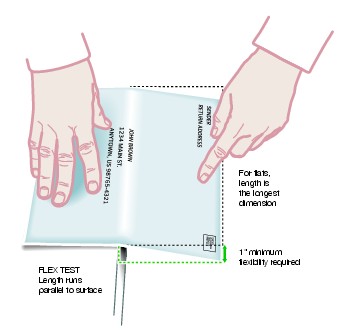
b. Flats 10 inches or longer that pass the test in 1.3a and contain a rigid insert (see Exhibit 1.3b):
1. Place the piece with the length perpendicular to the edge of a flat surface and extend the piece 5 inches off the surface.
2. Press down on the piece at a point 1 inch from the outer edge, in the center of the piece's width, exerting steady pressure.
3. Turn the piece around and repeat steps 1 and 2. The piece is flexible if both ends can bend at least 2 inches vertically without being damaged.
Exhibit 1.3b Flexibility Test—Flats 10 Inches or Longer
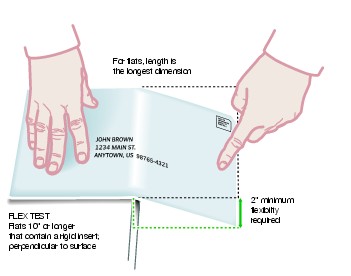
c. Flats less than 10 inches long that pass the test in 1.3a and contain a rigid insert ( see Exhibit 1.3c):
1. Place the piece with the length perpendicular to the edge of a flat surface and extend the piece one-half of its length off the surface.
2. Press down on the piece at a point 1 inch from the outer edge, in the center of the piece's width, exerting steady pressure.
3. Turn the piece around and repeat steps 1 and 2. The piece is flexible if both ends can bend at least 1 inch vertically without being damaged.
Exhibit 1.3c Flexibility Test—Flats Less Than 10 Inches Long
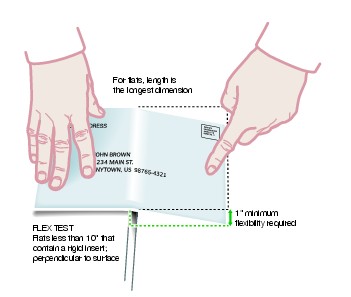
1.4 Uniform Thickness
[8-16-07] Flat-size mailpieces must be uniformly thick so that any bumps, protrusions, or other irregularities do not cause more than 1/4-inch variance in thickness. When determining variance in thickness, exclude the outside edges of a mailpiece (1 inch from each edge) when the contents do not extend into those edges. Also, exclude the selvage of any polywrap covering (see 3.3) from this determination. Mailers must secure nonpaper contents to prevent shifting of more than 2 inches within the mailpiece if shifting would cause the piece to be nonuniform in thickness or would result in the contents bursting out of the mailpiece (see 601.2.3).
1.5 Flat-Size Pieces Not Eligible for Flat-Size Prices
[7-15-07] Mailpieces that do not meet the standards in 1.1 through 1.4 are not eligible for flat-size prices and must pay applicable prices as follows:
a. First-Class Mail—parcel prices.
b. Standard Mail—Not Flat-Machinable or parcel prices.
c. Bound Printed Matter—parcel prices.
Back to Top
2.0 Physical Standards for Nonautomation Flats
2.1 First-Class Mail
These additional standards apply to First-Class Mail flat-size pieces:
a. First-Class Mail cannot exceed 13 ounces. First-Class Mail weighing more than 13 ounces is Priority Mail.
b. Flat-size pieces that do not meet the standards in 1.1 through 1.4 must be prepared as parcels and pay the applicable parcel price.
2.2 Standard Mail
2.2.1 Basic Physical Standards
These additional standards apply to Standard Mail flat-size pieces:
a. Each piece must weigh less than 16 ounces.
b. Flat-size pieces that do not meet the standards in 1.3 through 1.4 must be prepared as parcels or Not Flat-Machinable pieces and pay the parcel or Not Flat-Machinable prices (see 401).
2.2.2 Cover Page and Protective Cover
If the piece is not completely enclosed in a mailing wrapper, then any protective cover or cover page must cover both the front and back of the host publication and extend to within at least 3/4 inch of the edge opposite the fold or binding. Exception: Flat-size pieces may have short covers as provided in 3.5.2.
2.3 Bound Printed Matter
2.3.1 General Standards
These additional standards apply to Bound Printed Matter:
a. Flat-size pieces that do not meet the standards in 1.3 through 1.4 must be prepared as parcels and pay the applicable parcel prices.
b. Bound Printed Matter may not weigh more than 15 pounds.
c. Two or more flats may be mailed as a single piece if they are about the same size or shape or if they are parts of one article, if they are securely wrapped or fastened together, and if they do not together exceed the weight or size limits.
2.4 Media Mail
2.4.1 General Standards
These additional standards apply to Media Mail:
a. Flat-size pieces that do not meet the standards in 1.3 through 1.4 must be prepared as parcels.
b. No piece may weigh more than 70 pounds.
c. Two or more flats may be mailed as a single piece if they are about the same size or shape or if they are parts of one article, if they are securely wrapped or fastened together, and if they do not together exceed the weight or size limits.
2.5 Library Mail
2.5.1 General Standards
These additional standards apply to Library Mail:
a. Flat-size pieces that do not meet the standards in 1.3 through 1.4 must be prepared as parcels.
b. No piece may weigh more than 70 pounds.
c. Two or more flats may be mailed as a single piece if they are about the same size or shape or if they are parts of one article, if they are securely wrapped or fastened together, and if they do not together exceed the weight or size limits.
Back to Top
3.0 Physical Standards for Automation Flats
3.1 Basic Standards for Automation Flats
Flat-size pieces claimed at automation prices must meet the standards in 3.0 and the eligibility standards for the class of mail and price claimed. Pieces prepared with polywrap film must meet the standards in 3.3.
3.2 Additional Criteria for Automation Flats
3.2.1 Shape and Size
[7-15-07] Each flat-size piece must be rectangular, except that flat-size mailpieces may have finished corners that do not exceed a radius of 0.125 inch (1/8 inch). See Exhibit 1.1c. The following minimum and maximum dimensions apply to First-Class Mail, Standard Mail, Periodicals (except under 707.26.0), and Bound Printed Matter pieces:
a. Minimum height is 5 inches. Maximum height is 12 inches.
b. Minimum length is 6 inches. Maximum length is 15 inches.
c. For bound or folded pieces, the edge perpendicular to the bound or folded edge may not exceed 12 inches.
d. Minimum thickness is 0.009 inch. Maximum thickness is 0.75 inch.
3.2.2 Maximum Weight
Maximum weight limits are as follows:
a. For First-Class Mail, 13 ounces.
b. For Periodicals, 20 ounces.
c. For Standard Mail, less than 16 ounces.
d. For Bound Printed Matter, 20 ounces.
3.2.3 Maximum Deflection for Automation Flat-Size Pieces
An automation flat-size mailpiece must be flexible (see 1.3) and must meet maximum deflection standards. Test deflection as follows:
a. For pieces 10 inches or longer (see Exhibit 3.2.3a):
1. Place the piece with the length perpendicular to the edge of a flat surface and extend the piece 5 inches off the surface. Turn the piece around and repeat the process.
2. The piece is automation-compatible if it does not droop more than 4 inches vertically.
Exhibit 3.2.3a Deflection Test—Pieces 10 Inches or Longer
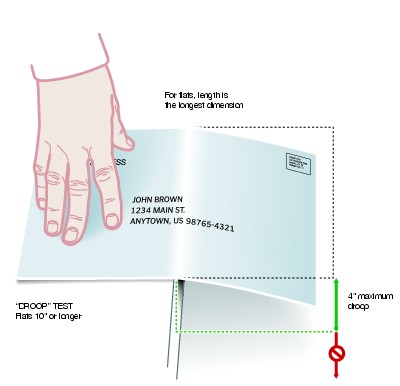
b. For pieces less than 10 inches long (see Exhibit 3.2.3b):
1. Place the piece with the length perpendicular to the edge of a flat surface and extend the piece one-half of its length off the surface. Turn the piece around and repeat the process.
2. The piece is automation-compatible if it does not droop more than 1 inch less than the extended length. For example, a piece 8 inches long would extend 4 inches off a flat surface. It must not droop more than 3 inches vertically.
Exhibit 3.2.3b Deflection Test—For Pieces Less Than 10 Inches Long
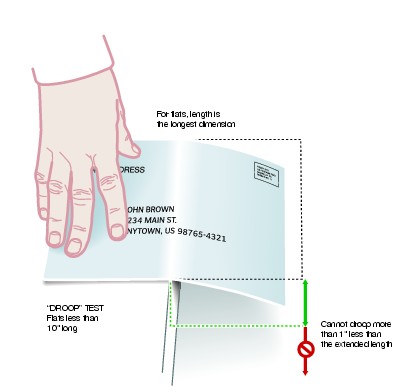
c. For pieces with bound or folded edges, perform the test in 3.2.3a or 3.2.3b above by placing the bound or final folded edge perpendicular to the edge of the flat surface.
3.3 Polywrap Coverings
3.3.1 Polywrap Films and Similar Coverings
When mailers use polywrap film or similar material to enclose flat-size mailpieces claimed at automation prices, the material must meet the standards in 3.3. Film approved for use under 3.3.5 must meet the specifications in Exhibit 3.3.1 as follows:
a. Films or similar coverings must meet all six properties in Exhibit 3.3.1.
b. If the address label is affixed to the outside of the polywrap, the haze property (property 2) does not apply.
Exhibit 3.3.1 Polywrap Specifications
Mailers who polywrap automation-price flats must use polywrap that meets all of the properties in this exhibit.
|
|
|
|
|
<0.45
|
USPS-T-3204
Section 4.5.2
|
|
|
0.20 to 0.55
|
USPS-T-3204
Section 4.5.1
|
|
<70
|
USPS-T-3204
Section 4.5.3
|
Affixing address labels to outside of polywrap is an alternative to meeting this requirement.
|
|
|
|
|
|
>50,000 psi
|
USPS-T-3204
Section 4.5.4
|
|
|
>40,000 psi
|
USPS-T-3204
Section 4.5.4
|
|
>0.001 in
|
USPS-T-3204
Section 4.5.5
|
|
|
<2.0 kV
|
USPS-T-3204
Section 4.5.7
|
|
|
<15 g
|
USPS-T-3204
Section 4.5.6
|
To be conducted at
140 (�3.6�) degrees Fahrenheit.
|
3.3.2 Wrap Direction and Seam Placement
Wrap direction, seam direction, and seam placement must follow these standards:
a. The wrap direction must be around the longer axis of the mailpiece, with the seam parallel to that axis. The longer axis is always parallel to the length of the mailpiece.
b. The preferred seam placement is on the nonaddressed side of the mailpiece. If the seam is placed on the addressed side, the seam must not cover any part of the delivery address and barcode, postage area, or any required markings or endorsements. Regardless of seam placement, the polywrap over the address area must be a smooth surface to avoid interference with address and barcode readability.
3.3.3 Overhang
For purposes of the polywrap standards for overhang (selvage) only, the top edge of the mailpiece is one of the two physically longer edges of the piece, regardless of address orientation and whether bound or unbound. Any polywrap overhang (selvage) around the four edges of the mailpiece (top, bottom, and left and right sides) must meet these standards:
a. When the mailpiece contents are totally positioned at the bottom of the polywrap, the overhang must not be more than 0.5 inch at the top of the mailpiece.
b. When the mailpiece contents are totally positioned to the left or to the right side of the polywrap, the overhang must not be more than 1.5 inches on the opposite side.
c. The polywrap covering must not be so tight that it bends the mailpiece.
3.3.4 Polywrap on Mailpieces
Mailers claiming automation flat prices for polywrapped pieces must use polywrap that meets the specifications in 3.3.1. Only products listed on the USPS RIBBS Web site (http://ribbs.usps.gov) may be used on automation-price flats.
3.3.5 Polywrap Certification Process for Manufacturers
To ensure that all polywrap manufacturers use the same criteria in meeting the new specifications, the Postal Service developed specification USPS-T-3204, Test Procedures for Automatable Polywrap Films. This specification describes exact test procedures and acceptable values for polywrap film characteristics. Independent testing laboratories may certify products for manufacturers who do not have the facilities or experience to conduct each of the test procedures in specification USPS-T-3204. The specification includes a list of laboratories experienced in conducting these tests. Customers may obtain the new test procedures by contacting USPS Engineering (see 608.8.1 for address) or on the USPS RIBBS Web site (http://ribbs.usps.gov). Manufacturers must submit a letter, on their letterhead, indicating the value for each of the specifications in 3.3.1 for each polywrap film, to USPS Mailing Standards (see 608.8.1 for address). When USPS receives the certificate of conformance, films with values meeting the standards will be listed on http://ribbs.usps.gov. Manufacturers should follow this process before submitting the letter certifying compliance with the specifications:
a. Test each film according to procedures listed in USPS-T-3204, Test Procedures for Automatable Polywrap Films.
b. Test each surface treatment separately. Manufacturers may test the thinnest film of one product with identical surface treatment and characteristics. If the thinnest film satisfactorily meets the characteristics after being tested, USPS will list the product as approved for all gauges of that product that also meet the gauge test.
3.4 Prohibitions
3.4.1 Protrusions
Clasps, strings, buttons, or like materials, or other protrusions that impede or damage mail processing equipment are prohibited.
3.4.2 Staples
Staples must not be substituted for tabs or wafer seals on pieces in automation price mailings. As a binding method, staples may be placed in the fold or spine of a magazine or booklet-type or similar mailpiece if parallel with the bound edge, tightly and securely inserted, and not protruding to damage or interfere with mail processing equipment.
3.5 Tabs, Wafer Seals, Tape, and Glue
3.5.1 General
Although not required, mailpieces may be prepared with tabs, wafer seals, cellophane tape, or permanent glue (continuous or spot) if these sealing devices do not interfere with the recognition of the barcode, price marking, postage information, and delivery and return addresses. Cellophane tape may not be placed over the barcode or where any part of the barcode will be printed. Tabs or seals placed in the area on which any part of the barcode is printed must contain a paper face meeting the standards for background reflectance. Tabs, wafer seals, and tape must have a peel adhesion (shear strength) value of at least 15 ounces/inch at a speed of 12 inches/minute after application to a stainless steel plate; the test is to be conducted 10 minutes after the material is applied to the plate.
3.5.2 Short Covers
Flats may be prepared with a cover page or protective cover that is more than 3/4 inch from each edge if the cover page is secured with at least two tabs, wafer seals, or glue spots placed within 1 inch of the top and bottom edges of the cover page or protective cover.
3.6 Uniformity and Exterior Format
3.6.1 General
A flat-size mailpiece prepared and claimed at automation prices must be uniformly thick (see 1.4). Each flat-size mailpiece must have a smooth and regular shape and be free of creases, folds, tears, or other irregularities not compatible with automation equipment. The exterior surface must not have protuberances caused by prohibited closures; attachments (except as provided below); irregularly shaped or distributed contents; or untrimmed excess material from the envelope, wrapper, or sleeve.
3.6.2 Outside Attachment
An attachment to a flat-size mailpiece must be a single sheet, the same size as the cover. The attachment must be permanently, securely, and uniformly affixed to the front or back cover along a bound, folded, or otherwise closed edge. Pieces claimed at a Periodicals price may bear attachments only if permitted by the applicable standards.
3.6.3 Booklet-Type Piece or Magazine
The contents of flat-size mailpieces prepared in sleeves or other wrappers must be sufficiently secure in the sleeve or wrapper to stay in place during processing. If material bearing the delivery address or barcode for the mailpiece is enclosed in a partial wrapper, that wrapper must be sufficiently secure to prevent the contents from shifting and obscuring the delivery address or barcode.
3.7 Outside Labels and Stickers
3.7.1 Use
Permanent labels and stickers (those designed not to be removed or relocated) must be affixed directly to the outside of the mailpiece with permanent adhesive. A mailer may provide recipients with relocatable labels to place on the outside of response pieces sent back to the mailer. On pieces mailed at Periodicals prices, labels and stickers may be used only if permitted by the applicable standards.
3.7.2 Pressure-Sensitive Label
Any pressure-sensitive label or sticker affixed directly to a mailpiece before mailing must have a minimum peel adhesion to stainless steel of 8 ounces/inch. This standard does not apply to pressure-sensitive labels provided by the USPS to label bundles to sortation levels.
3.7.3 "Sandwich" Label
A face stock/liner label ("sandwich" label) is a two-part unit with a face stock (top label) attached to a liner (bottom label) affixed to the mailpiece. The face stock must have a peel adhesion value of at least 2 ounces/inch with respect to the liner label and at least 8 ounces/inch when reapplied to stainless steel.
Back to Top





